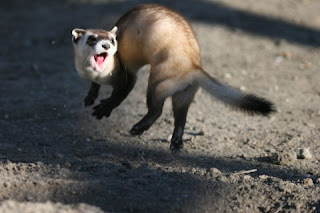This week, I want to bring you a very cute little fellow: the least weasel. I almost didn't see this guy as he is very tiny. The males range from 8 to 10 inches, and the females can only be as big as 4.5 to 8 inches. How very tiny! And I think that their minuscule size is really their most noticeable quality IF you actually are able to notice them.
Least weasels are natives of Eurasia, North America, and North Africa. They commonly have a brown coat with a white belly. They also have a white winter coat which is similar to the stoats. I think either looks pretty good on them. It's safe to say that the least weasel is cute. How could something so small be ferocious?
Well, in a way, he kind of is. As tiny as this mustie is in size, he is actually very good at killing. Yes, most of what he kills are mice and other rodents, but they also--very professionally--go after larger prey such as hares and medium sized birds. That is very unusual if you consider that a hare is one of the larger, bulkier class of rabbits. Pretty good for a itty bitty weasel who hops around wherever he goes. Yep, he really does that!
The least weasel has its place in fiction. In Ancient Macedon, if a women got a head ache after washing her face, she might assume that a least weasel had been using the water as a mirror beforehand; however, she would not dare mention the weasel's name for fear that he will become vindictive and destroy all her clothing! Goodness! In Greece, there was a similar story about a bride who's bitterness turned her into a least weasel who would go about destroying the clothing of other brides-to-be.
In a story by a Roman author called Pliny the Elder, a least weasel managed to destroy a basilisk (basically a large reptilian monster) by his odor alone. Even weirder, the Chippewa believed that a least weasel could slay a half-beast creature called a wendigo by scurrying up his anus! Lastly, in the English Civil War, least weasels were believed to be the familiar of witches.
I have actually read a novel that had a least weasel as a prominent main character. In the "Welkin Weasels" series by Garry Kilworth, there was a very tiny weasel named Miniver who was very cute and still a very capable and resourceful animal in the team. In the book, they commonly referred to her as a "finger weasel" which was likely a more adorable way to explain what she was.
So what about me? I find it very amusing that something so small can be so brave and capable. I can see how these little creatures can be a strong force of either good or evil. They have a way to get things done despite their size, and that is what makes them so much fun. Least weasels may be small, but they can still be taken seriously. And they have proven it!
Thank you for reading this blog! If you enjoyed it, you can comment below, or you can email me at tooie@tooiekangaroo.com.

















































